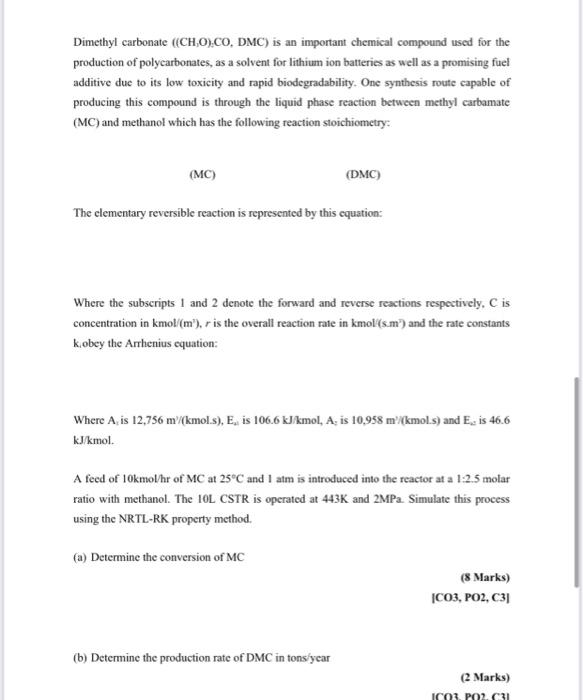Dimethyl carbonate (CHO).CO. DMC) is an important chemical compound used for the production of polycarbonates, as a solvent for lithium ion batteries as well as a promising fuel additive due to its low toxicity and rapid biodegradability. One synthesis route capable of producing this compound is through the liquid phase reaction between methyl carbamate (MC) and methanol which has the following reaction stoichiometry: (MC) (DMC) The elementary reversibic reaction is represented by this cquation: Where the subscripts 1 and 2 denote the forward and reverse reactions respectively. C is concentration in kmol/(m*), r is the overall reaction rate in kmol(s.m") and the rate constants kobey the Arrhenius equation: Where A is 12,756 m/(kmol.s), E. is 106.6 kJ/kmol, A. is 10,958 m/kmol.s) and E. is 46.6 kJ/kmol. A feed of 10kmolhr of MC at 25C and I atm is introduced into the reactor at a 1:2.5 molar ratio with methanol. The 10L CSTR is operated at 443K and 2MPa Simulate this process using the NRTL-RK property method. (a) Determine the conversion of MC (8 Marks) |CO3, PO2, C31 (b) Determine the production rate of DMC in tons/year (2 Marks) ICO. PO2.31 (c) Using design specification, determine the reactor operating temperature necessary to achieve 90% conversion of MC. (5 Marks) (CO3, PO2, C3) (d) It is desired to scale up the process to produce 50,000 tons/year of DMC, demonstrate with your simulation how you would achieve this production rate and explain the steps you used. (5 Marks) CO3, PO2, C31 Dimethyl carbonate (CHO).CO. DMC) is an important chemical compound used for the production of polycarbonates, as a solvent for lithium ion batteries as well as a promising fuel additive due to its low toxicity and rapid biodegradability. One synthesis route capable of producing this compound is through the liquid phase reaction between methyl carbamate (MC) and methanol which has the following reaction stoichiometry: (MC) (DMC) The elementary reversibic reaction is represented by this cquation: Where the subscripts 1 and 2 denote the forward and reverse reactions respectively. C is concentration in kmol/(m*), r is the overall reaction rate in kmol(s.m") and the rate constants kobey the Arrhenius equation: Where A is 12,756 m/(kmol.s), E. is 106.6 kJ/kmol, A. is 10,958 m/kmol.s) and E. is 46.6 kJ/kmol. A feed of 10kmolhr of MC at 25C and I atm is introduced into the reactor at a 1:2.5 molar ratio with methanol. The 10L CSTR is operated at 443K and 2MPa Simulate this process using the NRTL-RK property method. (a) Determine the conversion of MC (8 Marks) |CO3, PO2, C31 (b) Determine the production rate of DMC in tons/year (2 Marks) ICO. PO2.31 (c) Using design specification, determine the reactor operating temperature necessary to achieve 90% conversion of MC. (5 Marks) (CO3, PO2, C3) (d) It is desired to scale up the process to produce 50,000 tons/year of DMC, demonstrate with your simulation how you would achieve this production rate and explain the steps you used. (5 Marks) CO3, PO2, C31








